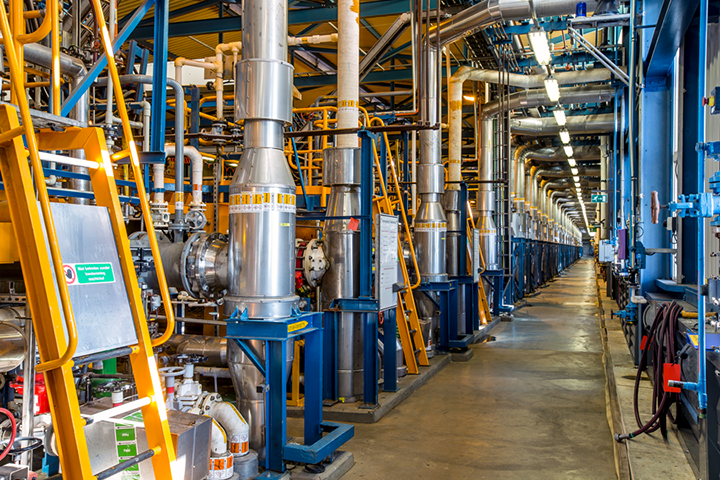On the road to meeting the targets of the Paris Climate Agreement, the world has mostly focused on energy production. But the decarbonization of large industries may pose an even bigger challenge, and one that is largely reliant on our ability to scale up the production of green hydrogen.
While wind, solar and hydropower provide viable clean alternatives for energy made from fossil fuels, industrial processes cannot run on electricity alone. For example, steel manufacturing, which accounts for eight percent of global emissions, not only relies on coal and gas to reach sufficiently high temperatures, but also for the reduction of iron to make steel. Other examples of so-called “hard-to-abate industries” are cement, chemicals and fertilizers, as well as the aviation and shipping industries, which still rely on fuels with high energy density.
While the technical details vary per industry, the solution to decarbonize each of these sectors has one element in common: hydrogen. Specifically, green hydrogen, which is made by splitting water into oxygen and hydrogen using renewable power in a process called water electrolysis. No CO2 is emitted during this process and, when the hydrogen is used, the only emission is water.
This not only makes it suitable as a sustainable fuel for heavy transport and shipping, but it can also be used for industrial applications. For example, hydrogen can be used to produce steel without CO2 emissions, using a process for direct reduced iron (DRI), or to replace fossil-based raw materials in the production of fertilizers.
Moreover, electrolysis factories are highly flexible and can quickly adjust production levels to available electricity supplies, thus helping balance the swings in production from intermittent sources such as wind and solar.
Green hydrogen is the linking pin which helps turn green electrons into green molecules. Electrolysis will help balance and store excess energy from renewable sources, by converting power into hydrogen, which can then be used to produce steel, cement, plastics and other essentials with net zero emissions.
The energy transition will largely be dictated by our ability to produce green hydrogen at scale in an affordable, reliable and safe way.
Falling Cost
Electrolysis technology is over a century old and is already deployed at a large scale by the chemical industry to produce chlorine and caustic soda, two basic chemicals used to produce a range of materials. Hydrogen is still being produced mostly from natural gas, however, as this was traditionally cheaper than using water electrolysis. But this is changing, as the price of water electrolysis is being pushed down due to increases in size, technology development and plant efficiency.
Firstly, there are still significant improvements at the fundamental level, as research is ramping up to increase the efficiency of the elektrolysers themselves, helping to turn more of the electricity into hydrogen and preventing losses in the form of heat. Already, modern elektrolysers can make five to ten times more hydrogen than traditional models with the same amount of surface area. Researchers across the globe are working to improve electrodes, membranes, cell designs and all other aspects of the technology to increase efficiency and bring down costs.
Secondly, we will see increasing benefits from economies of scale in the coming years. Currently, the largest alkaline water electrolysis installation in Europe is only 10 megawatts (mw) and the Djewels project of HyCC and Gasunie in the Netherlands will be among of the first in Europe to go beyond this, with 20 mw. To decarbonize our industries however, we will have to scale up to several gigawatts (one gigawatt = 1,000 megawatts).
At that scale, cost savings are realized both at the plant level and in the supply chain. Currently, elektrolyser stacks are still largely made by hand and production will become markedly cheaper with automation and scale. The same is true for all the other equipment and components used in an electrolysis factory. Moreover, larger factories can be designed more efficiently, making better use of ancillary equipment such as compressors, pumps and control systems.
In short, equipment will become more efficient, cheaper to produce, and we will need less of it. A consortium of researchers and companies led by Dutch research group ISPT recently showed that based on plant design alone, hydrogen produced at gigawatt scale in 2030 would cost only a third of current prices for green hydrogen.
Stepwise Approach
To reap the full benefits of these improvements, green hydrogen production should be scaled-up in a stepwise manner, as is currently being done in leading green hydrogen markets such as the Netherlands.
There, the Djewels project announced in 2017, in combination with HyCC’s experience with large-scale electrolysis to produce chlor-alkali, formed the basis for further growth. The project was soon followed with plans for a 40-megawatt expansion to provide hydrogen for sustainable aviation fuels, a 100-megawatt plant near Amsterdam for the production of sustainable steel, and a 250-megawatt project in Rotterdam to help decarbonize one of Europe’s biggest refineries.
With access to offshore wind power along its coastline and strong existing chemical clusters, the Netherlands is well positioned to develop its hydrogen economy, and companies like Shell and RWE have recently followed suit with more large water-electrolysis projects.
Kickstarting the Hydrogen Economy
All these projects will not only help decarbonize industry, but also contribute to the development of technology and help kickstart the hydrogen economy. For years, hydrogen was caught in a chicken and egg dilemma, as suppliers were leery to start large projects without sufficient demand and customers were equally hesitant to invest in hydrogen technology without security of supply.
This is now starting to change. In the north of the Netherlands, HyCC’s first project led to the creation of a “Hydrogen Valley,” attracting new customers and suppliers to the region. In Amsterdam, the 100 mw plant for steel production fostered discussions around circular chemistry in the nearby port area and in Rotterdam, the announcement of HyCC and bp for a large-scale green hydrogen facility was followed by a spur of projects in both supply and demand. And, in all of these regions, the promise of green hydrogen not only pertained to industries, but also prompted plans for green mobility based on hydrogen fuel cells, ranging from buses and trucks to the first inland shipping vessels.
The energy transition is often displayed as a cost item on our energy bill. This not only vastly underestimates the scope and size of the transition, but also fails to appreciate the opportunity ahead of us. In the next two decades, we will see entire industries transform, and perhaps even be replaced, as we move to a circular and sustainable economy in which wind and water will replace oil and gas. Rather than focusing on its cost, we should be asking ourselves: How can we best seize this opportunity?
Headline photo courtesy of HyCC. 200-megawatt electrolysis facility at HyCC’s parent company, Nobian, in Rotterdam, for the production of chlor-alkli, using technology similar to that which will be used for hydrogen production.
Marcel Galjee presides as managing director HyCC (the Hydrogen Chemistry Company), a leading industrial partner for safe and reliable green hydrogen supplies and circular chemistry solutions to enable the transition to zero-carbon industry. HyCC is a joint venture of Macquarie’s Green Investment Group and electrochemical company Nobian, bringing more than 100 years of experience in electrolysis and leadership in safety.
Prior to his present role, Galjee worked as vice president energy and new business for Nouryon and AkzoNobel Specialty Chemicals, as an international consultant at PwC, and in various energy related functions at Vattenfall, Sweden, Germany and the Netherlands.



